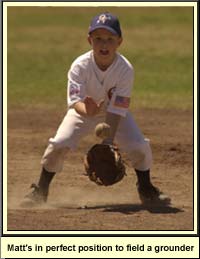Fielding Ground Balls
Ground Ball Hit At You

Unless the ball is absolutely ripped at you and you don't have time, get in the habit of moving toward the grounder as you prepare to field it. Notice the word 'charge' wasn't used -- that word implies running towards it as fast as you can. Unless it's a slow roller, you want to approach the ball in a controlled manner that is aggressive but not out of control. This allows you to make adjustments so you're not catching it off a short hop or taking it off the first bounce on the infield dirt. As you get closer to the ball, begin breaking down to get into position to field the ball. To do this, shorten your steps and widen your feet. Bend not only at the knees but also with your back. Put your hands out in front of your body and open your glove toward the ball with your bare hand on top.
Catching The Ground Ball
There are a few common problems that players make when catching a ground ball.
- Not catching the ball out in front.
By doing this, you cannot watch the ball all the way into your glove; most likely you are bending either with your knees or back but not both.
When you catch the ball under you, you loose the ability to give with your hands. You want 'soft hands', a term used to describe a fielder who catches the ball out front of his body and seems to suck up the ball from that position into a position to throw. With soft hands, you can make last second adjustments to a bounce that was different than expected. - Poorly Positioned Hands
Your glove must be in a good position to field the ball: open and close to vertical. This gives you the most area to catch the ball.
Istructional Video on Fielding a Ground Ball from NAYS (National Alliance of Youth Sports)
Short Hop
In all situations, try to avoid catching the ball on a short hop. In the diagram below, the approximate area of the short hop is shown in red. Catching the ball on a short hop is a difficult play to make. It takes practice for players to get in good position to avoid fielding a short hop. The following link is a good drill for players to work on the necessary footwork for avoiding a short hop: Short Hop Drill

Backhand
The backhand play is one of the most difficult to make. Poor technique and lack of practice are two of the biggest reasons why players struggle with the backhand play.
As you approach the ball you will either field it with your left foot forward or right foot forward depending on when you get to it. Many players will practice fielding a backhand only one way, but the fact is you will have to make the play both ways so make sure you practice both ways of fielding a backhand. Either way you want to make sure you keep your glove in front of your face. You want to watch the ball all the way into the glove.
Istructional Video on Fielding a Ground Ball Backhanded from NAYS (National Alliance of Youth Sports)
Most Recent Blog Posts
Working With Players on Focusing on the Correct Part of the Baseball when Hitting (October 15 2016)
Getting More Accurate Throws From Your Team (April 5 2016)
Thanks for all the great information and drills! I've used the site all season and it's made my life so much easier.
- Jim N.







